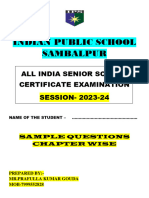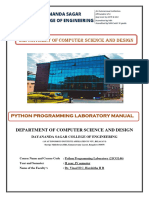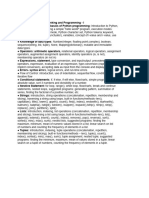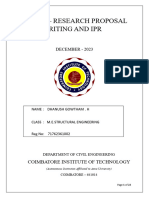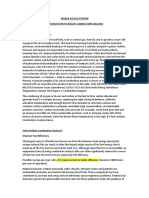Lab Manual Python-2
Uploaded by
akshairaj420Lab Manual Python-2
Uploaded by
akshairaj420Academic Year: Course Name with Sub Code Scheme/sem.
/subject
code /Version no.
SUB CODE: COURSE NAME
LAB MANUAL<TEACHER’S/STUDENT’S>
PREPARED BY: APPROVED BY:
1. <Faculty Name with Signature> HOD, <Dept.>
2. < Faculty Name with Signature>
LAB IN CHARGE:
DEPT. OF <DEPT. NAME>, ADISHANKARA INSTITUTE OF ENGINEERING & TECHNOLOGY, KALADY
Academic Year: Course Name with Sub Code Scheme/sem./subject
code /Version no.
ASIET VISION
To emerge as a Center of Excellence in Engineering, Technology and Management by
imparting quality education, focusing on empowerment and innovation.
ASIET MISSION
Impart quality professional education for total upliftment of the society.
Create congenial academic ambience that kindles innovative thinking and research.
Mould competent professionals who are socially committed and responsible citizens.
VISION OF THE DEPARTMENT
MISSION OF THE DEPARTMENT
COURSE SYLLABUS
COURSE OUTCOMES
After the completion of this course, students shall be able to:
DEPT. OF <DEPT. NAME>, ADISHANKARA INSTITUTE OF ENGINEERING & TECHNOLOGY, KALADY
Academic Year: Course Name with Sub Code Scheme/sem./subject
code /Version no.
CO Course Knowledge
No. Outcome Level
CO1
CO2
CO3
CO4
CO-PO AND CO-PSO MAPPING
CO\ PO PO PO PO PO PO PO PO PO PO1 PO PO1 PS PS PS
PO 1 2 3 4 5 6 7 8 9 0 11 2 O1 O2 O
3
&PS
O
1
GENERAL INSTRUCTIONS (for the lab)
BEST PRACTICES
INDEX
DEPT. OF <DEPT. NAME>, ADISHANKARA INSTITUTE OF ENGINEERING & TECHNOLOGY, KALADY
Academic Year: Course Name with Sub Code Scheme/sem./subject
code /Version no.
Exp No. Expt. Name Page Number
EXP NO:1
DEPT. OF <DEPT. NAME>, ADISHANKARA INSTITUTE OF ENGINEERING & TECHNOLOGY, KALADY
Academic Year: Course Name with Sub Code Scheme/sem./subject
code /Version no.
BASICS OF PYTHON PROGRAMMING
OBJECTIVE:
●To understand the basics of python programming
LEARNING OUTCOMES:
● To demonstrate the fundamental concepts of Python programming by
writing and executing simple Python scripts that effectively solve
basic computational problems.
SOFTWARE REQUIRED:
Python IDLE (Integrated Development and Learning Environment)
THEORY:
The print() function in Python is one of the most frequently used functions,
and its purpose is to output data to the standard output device, typically the
console or terminal.
The input() function in Python is used to accept user input from the standard
input device, typically the keyboard.
ALGORITHM/FLOW CHART:
(1) Print your name and address
1. Start
2. Print the user's name.
3. Print the user's address.
4. End
(2) Assign values to variables and print their values
1. Start
DEPT. OF <DEPT. NAME>, ADISHANKARA INSTITUTE OF ENGINEERING & TECHNOLOGY, KALADY
Academic Year: Course Name with Sub Code Scheme/sem./subject
code /Version no.
2. Assign a value to variable x.
3. Assign a value to variable y.
4. Assign a value to variable z.
5. Print the value of x.
6. Print the value of y.
7. Print the value of z.
8. End
CODE:
(1) Print your name and address
name = "John Doe"
address = "1234 Elm Street, Springfield, USA"
print("Name:", name)
print("Address:", address)
(2) Print multiple items
print("Python", "is", "fun!")
(3) Print multi-line string
print("""This is a multi-line string.
It can span multiple lines.
You can use triple quotes to write it.""")
(4) Assign values to variables and print their values
x = 10
y = 20.5
z = "Hello, World!"
print("Value of x:", x)
print("Value of y:", y)
DEPT. OF <DEPT. NAME>, ADISHANKARA INSTITUTE OF ENGINEERING & TECHNOLOGY, KALADY
Academic Year: Course Name with Sub Code Scheme/sem./subject
code /Version no.
print("Value of z:", z)
print(x,y,z)
(5) Print with Formatted String (f-strings)
name = "Alice"
age = 25
city = "New York"
print(f"My name is {name}. I am {age} years old and I live in {city}.")
(6) Print with Separator and End Parameter
print("Apple", "Banana", "Cherry", sep=", ")
print("Learning Python", end=" ")
print("is fun!")
(7) Use Concatenation in Print
first_name = "John"
last_name = "Doe"
age = 30
full_name = first_name + " " + last_name
print("Full Name: " + full_name)
print("Welcome, " + first_name + "! Today is a great day.")
(8) Prompts the user for a name and print a greeting
name = input("Enter your name: ")
print("Hello, " + name + "!")
(9) Taking multiple inputs
value1, value2, value3 = input("Enter three values ").split()
print(f"Value 1: {value1}")
print(f"Value 2: {value2}")
print(f"Value 3: {value3}")
DEPT. OF <DEPT. NAME>, ADISHANKARA INSTITUTE OF ENGINEERING & TECHNOLOGY, KALADY
Academic Year: Course Name with Sub Code Scheme/sem./subject
code /Version no.
PROCEDURE:
(1) Set Up Your Development Environment (Choose an IDE, Install
Python)
(2) Write the Code
(3) Use comments
(4) Run Your Code
(5) Debug your code, if you encounter errors
(6) Review Your Code
(7) Optimize
EXPECTED OUTPUT:
(1) Print your name and address
Name: John Doe
Address: 1234 Elm Street, Springfield, USA
(2) Print multiple items
Python is fun!
(3) Print multi-line string
This is a multi-line string.
It can span multiple lines.
You can use triple quotes to write it.
(4) Assign values to variables and print their values
Value of x: 10
Value of y: 20.5
Value of z: Hello, World!
10 20.5 Hello, World!
(5) Print with Formatted String (f-strings)
My name is Alice. I am 25 years old and I live in New York.
(6) Print with Separator and End Parameter
DEPT. OF <DEPT. NAME>, ADISHANKARA INSTITUTE OF ENGINEERING & TECHNOLOGY, KALADY
Academic Year: Course Name with Sub Code Scheme/sem./subject
code /Version no.
Apple, Banana, Cherry
Learning Python is fun!
(7) Use Concatenation in Print
Full Name: John Doe
Welcome, John! Today is a great day.
(8) Prompts the user for a name and print a greeting
Input
Enter your name: John
Output
Hello, John!
(9) Taking multiple inputs
Enter three values 5 30 22
Value 1: 5
Value 2: 30
Value 3: 22
MODEL / VIVA QUESTIONS:
1. What are the key features of Python?
2. How do you create a variable in Python?
3. List the rules for naming a variable
4. How do you take input from the user in Python?
INFERENCE:
The programs which demonstrate the basics of python programming language
are successfully executed and the results are obtained.
EXP NO:2
DEPT. OF <DEPT. NAME>, ADISHANKARA INSTITUTE OF ENGINEERING & TECHNOLOGY, KALADY
Academic Year: Course Name with Sub Code Scheme/sem./subject
code /Version no.
DATA TYPES IN PYTHON PROGRAMMING
OBJECTIVE:
●To understand the basics data types of python programming
LEARNING OUTCOMES:
● To demonstrate the fundamental Data types in Python Programming
SOFTWARE REQUIRED:
Python IDLE (Integrated Development and Learning Environment)
THEORY:
Integers (int): Whole numbers, positive or negative, without decimals.
Floating Point Numbers (float): Numbers that have a decimal point.
Strings (str): A sequence of characters.
Booleans (bool): Represents True or False values.
Lists (list): Ordered, mutable collections of items.
Tuples (tuple): Ordered, immutable collections of items.
Dictionaries (dict): Unordered, mutable collections of key-value pairs.
Sets (set): Unordered collections of unique items.
ALGORITHM/FLOW CHART:
(3) Simple Interest
1. Start.
2. Input the principal amount P.
3. Input the rate of interest R.
4. Input the time period T.
5. Calculate the simple interest using the formula:
SI=P×R×T/100
6. Display the calculated Simple Interest SI.
7. End.
(5) Print the imaginary and real parts of complex number
DEPT. OF <DEPT. NAME>, ADISHANKARA INSTITUTE OF ENGINEERING & TECHNOLOGY, KALADY
Academic Year: Course Name with Sub Code Scheme/sem./subject
code /Version no.
1. Start.
2. Input the complex number z.
3. Extract the real part of z using the attribute z.real.
4. Extract the imaginary part of z using the attribute z.imag.
5. Display the real part (z.real).
6. Display the imaginary part (z.imag).
7. End.
CODE:
(1) Print the data types of different variables
int_var = 10
print(f"Integer: {int_var}, Type: {type(int_var)}")
float_var = 10.5
print(f"Float: {float_var}, Type: {type(float_var)}")
complex_var = 10+2j
print(f"Complex: {complex_var}, Type: {type(complex_var)}")
str_var = "Hello, Python!"
print(f"String: '{str_var}', Type: {type(str_var)}")
bool_var = True
print(f"Boolean: {bool_var}, Type: {type(bool_var)}")
list_var = [1, 2, 3, 4, 5]
print(f"List: {list_var}, Type: {type(list_var)}")
tuple_var = (1, 2, 3)
print(f"Tuple: {tuple_var}, Type: {type(tuple_var)}")
dict_var = {"name": "Alice", "age": 25}
print(f"Dictionary: {dict_var}, Type: {type(dict_var)}")
set_var = {1, 2, 3, 4, 5}
print(f"Set: {set_var}, Type: {type(set_var)}")
(2) Convert temperature from Celsius to Fahrenheit using the
formula F = (C * 9/5) + 32.
celsius = 36.6
fahrenheit = (celsius * 9/5) + 32
print(f"Temperature in Celsius: {celsius}")
print(f"Temperature in Fahrenheit: {fahrenheit:.2f}")
(3) Calculate simple interest using the formula SI = (P * R * T) / 100,
where P is the principal amount, R is the rate of interest, and T is
the time in years.
DEPT. OF <DEPT. NAME>, ADISHANKARA INSTITUTE OF ENGINEERING & TECHNOLOGY, KALADY
Academic Year: Course Name with Sub Code Scheme/sem./subject
code /Version no.
principal = 1000.0
rate = 5.5
time = 2.5
simple_interest = (principal * rate * time) / 100
print(f"Principal Amount: {principal}")
print(f"Rate of Interest: {rate}%")
print(f"Time (in years): {time}")
print(f"Simple Interest: {simple_interest:.2f}")
(4) Create complex numbers and do basic operations such as
addition, subtraction, multiplication, and division.
z1 = complex(2, 3)
z2 = complex(1, 4)
add_result = z1 + z2
print(f"Addition: {z1} + {z2} = {add_result}")
sub_result = z1 - z2
print(f"Subtraction: {z1} - {z2} = {sub_result}")
mul_result = z1 * z2
print(f"Multiplication: {z1} * {z2} = {mul_result}")
div_result = z1 / z2
print(f"Division: {z1} / {z2} = {div_result}")
(5) Access real and imaginary parts of a complex number
z = complex(3, 5) # 3 + 5j
real_part = z.real
imaginary_part = z.imag
print(f"Complex Number: {z}")
print(f"Real Part: {real_part}")
print(f"Imaginary Part: {imaginary_part}")
(6) Compare two numbers and print the Boolean values True/False
num1 = 10
num2 = 5
is_greater = num1 > num2
is_equal = num1 == num2
is_less_equal = num1 <= num2
print(f"Is {num1} greater than {num2}? {is_greater}")
print(f"Is {num1} equal to {num2}? {is_equal}")
print(f"Is {num1} less than or equal to {num2}? {is_less_equal}")
(7) Create a string, list, tuple, set, dictionary and print them
DEPT. OF <DEPT. NAME>, ADISHANKARA INSTITUTE OF ENGINEERING & TECHNOLOGY, KALADY
Academic Year: Course Name with Sub Code Scheme/sem./subject
code /Version no.
my_string = "Hello, World!"
print(f"String: {my_string}")
my_list = [1, 2, 3, "apple", 5.6]
print(f"List: {my_list}")
my_tuple = (10, 20, 30, "orange")
print(f"Tuple: {my_tuple}")
# Set
my_set = {1, 2, 3, 4, 5}
print(f"Set: {my_set}")
my_dict = {
"name": "Alice",
"age": 25,
"city": "New York"
}
print(f"Dictionary: {my_dict}")
(8) Type Conversion/Type Casting
# String to Integer
str_num = "100"
int_num = int(str_num)
print(f"String '{str_num}' converted to integer: {int_num}")
# Integer to String
num = 123
str_num = str(num)
print(f"Integer {num} converted to string: '{str_num}'")
# Float to Integer
float_num = 9.78
int_num = int(float_num)
print(f"Float {float_num} converted to integer: {int_num}")
# Integer to Float
num = 45
float_num = float(num)
print(f"Integer {num} converted to float: {float_num}")
# String to Float
str_num = "3.1415"
float_num = float(str_num)
print(f"String '{str_num}' converted to float: {float_num}")
# List to Tuple
my_list = [1, 2, 3]
DEPT. OF <DEPT. NAME>, ADISHANKARA INSTITUTE OF ENGINEERING & TECHNOLOGY, KALADY
Academic Year: Course Name with Sub Code Scheme/sem./subject
code /Version no.
my_tuple = tuple(my_list)
print(f"List {my_list} converted to tuple: {my_tuple}")
# Tuple to List
my_tuple = (4, 5, 6)
my_list = list(my_tuple)
print(f"Tuple {my_tuple} converted to list: {my_list}")
# List to Set
my_list = [1, 2, 2, 3, 4]
my_set = set(my_list)
print(f"List {my_list} converted to set (duplicates removed):
{my_set}")
# Set to List
my_set = {7, 8, 9}
my_list = list(my_set)
print(f"Set {my_set} converted to list: {my_list}")
# Boolean to Integer
bool_val = True
int_val = int(bool_val)
print(f"Boolean {bool_val} converted to integer: {int_val}")
# Integer to Boolean
num = 0
bool_val = bool(num)
print(f"Integer {num} converted to boolean: {bool_val}")
num = 42
bool_val = bool(num)
print(f"Integer {num} converted to boolean: {bool_val}")
# String to Boolean
str_val = ""
bool_val = bool(str_val)
print(f"String '{str_val}' converted to boolean: {bool_val}")
str_val = "Hello"
bool_val = bool(str_val)
print(f"String '{str_val}' converted to boolean: {bool_val}")
PROCEDURE:
(1) Set Up Your Development Environment (Choose an IDE, Install
Python)
(2) Write the Code
DEPT. OF <DEPT. NAME>, ADISHANKARA INSTITUTE OF ENGINEERING & TECHNOLOGY, KALADY
Academic Year: Course Name with Sub Code Scheme/sem./subject
code /Version no.
(3) Use comments
(4) Run Your Code
(5) Debug your code, if you encounter errors
(6) Review Your Code
(7) Optimize
EXPECTED OUTPUT:
(1) Print the data types of different variables
Integer: 10, Type: <class 'int'>
Float: 10.5, Type: <class 'float'>
Complex: (10+2j), Type: <class 'complex'>
String: 'Hello, Python!', Type: <class 'str'>
Boolean: True, Type: <class 'bool'>
List: [1, 2, 3, 4, 5], Type: <class 'list'>
Tuple: (1, 2, 3), Type: <class 'tuple'>
Dictionary: {'name': 'Alice', 'age': 25}, Type: <class 'dict'>
Set: {1, 2, 3, 4, 5}, Type: <class 'set'>
(2) Celsius to Fahrenheit
Temperature in Celsius: 36.6
Temperature in Fahrenheit: 97.88
(3) Simple Interest
Principal Amount: 1000.0
Rate of Interest: 5.5%
Time (in years): 2.5
Simple Interest: 137.50
(4) Complex Numbers
Addition: (2+3j) + (1+4j) = (3+7j)
Subtraction: (2+3j) - (1+4j) = (1-1j)
Multiplication: (2+3j) * (1+4j) = (-10+11j)
(5) Real and Imaginary Parts
Complex Number: (3+5j)
DEPT. OF <DEPT. NAME>, ADISHANKARA INSTITUTE OF ENGINEERING & TECHNOLOGY, KALADY
Academic Year: Course Name with Sub Code Scheme/sem./subject
code /Version no.
Real Part: 3.0
Imaginary Part: 5.0
(6) Print Boolean values
Is 10 greater than 5? True
Is 10 equal to 5? False
Is 10 less than or equal to 5? False
(7) Create a string, list, tuple, set, dictionary
String: Hello, World!
List: [1, 2, 3, 'apple', 5.6]
Tuple: (10, 20, 30, 'orange')
Set: {1, 2, 3, 4, 5}
Dictionary: {'name': 'Alice', 'age': 25, 'city': 'New York'}
(8) Type conversion
String '100' converted to integer: 100
Integer 123 converted to string: '123'
Float 9.78 converted to integer: 9
Integer 45 converted to float: 45.0
String '3.1415' converted to float: 3.1415
List [1, 2, 3] converted to tuple: (1, 2, 3)
Tuple (4, 5, 6) converted to list: [4, 5, 6]
List [1, 2, 2, 3, 4] converted to set (duplicates removed): {1, 2, 3, 4}
Set {8, 9, 7} converted to list: [8, 9, 7]
Boolean True converted to integer: 1
Integer 0 converted to boolean: False
Integer 42 converted to boolean: True
String '' converted to boolean: False
String 'Hello' converted to boolean: True
MODEL / VIVA QUESTIONS:
1. What are data types?
2. List the data types in python
3. What is bool?
4. List the differences between list, tuple, set and dictionary
5. What do you mean by type casting?
INFERENCE:
DEPT. OF <DEPT. NAME>, ADISHANKARA INSTITUTE OF ENGINEERING & TECHNOLOGY, KALADY
Academic Year: Course Name with Sub Code Scheme/sem./subject
code /Version no.
The programs which demonstrate the fundamental data types are successfully
executed and the results are obtained.
EXP NO:3
DEMONSTRATE DIFFERENT ARITHMETIC OPERATIONS ON NUMBERS
OBJECTIVE:
●To understand different arithmetic operations in python
DEPT. OF <DEPT. NAME>, ADISHANKARA INSTITUTE OF ENGINEERING & TECHNOLOGY, KALADY
Academic Year: Course Name with Sub Code Scheme/sem./subject
code /Version no.
LEARNING OUTCOMES:
● To demonstrate the different arithmetic operations on numbers in
python.
● To apply fundamental python constructs in solving the basic
mathematical problems.
SOFTWARE REQUIRED:
Python IDLE (Integrated Development and Learning Environment)
THEORY:
Arithmetic operations in Python are simple to perform using basic operators.
Addition (+): Adds two numbers.
Subtraction (-): Subtracts one number from another.
Multiplication (*): Multiplies two numbers.
Division (/): Divides one number by another and returns a float result.
Floor Division (//): Divides one number by another and returns the
result as an integer (rounded down).
Modulus (%): Returns the remainder of the division.
Exponentiation (**): Raises one number to the power of another.
ALGORITHM/FLOW CHART:
(1) Area of the circle given the diameter
(1) Start
(2) Read diameter d
(3) Find radius = Diameter/2
(4) Compute area = pi * (radius) *(radius)
(5) Print (area)
(6) End
CODE:
DEPT. OF <DEPT. NAME>, ADISHANKARA INSTITUTE OF ENGINEERING & TECHNOLOGY, KALADY
Academic Year: Course Name with Sub Code Scheme/sem./subject
code /Version no.
(1) Area of the circle given the diameter
import math
diameter=int(input("enter the diameter"))
radius = diameter / 2
area = math.pi * (radius**2)
print(f"The area of the circle with diameter {diameter} is {area}")
(2) Calculate the area and perimeter of a rectangle given its length
and breadth
length = float(input("Enter the length of the rectangle: "))
breadth = float(input("Enter the breadth of the rectangle: "))
area = length * breadth
perimeter = 2 * (length + breadth)
print("Area:",area )
print("Perimeter:",perimeter)
(3) Find the hypotenuse of a right triangle using Pythagoras
theorem.
import math
b=int(input("Enter the base"))
a=int(input("Enter the altitude"))
temp=a**2+b**2
h=math.sqrt(temp)
print("The hypotenuse is",h)
(4) To input two values a and b and then swap them
a=int(input("Enter a number"))
b=int(input("Enter another number"))
print("The numbers before swapping are a =",a,"and b =",b)
temp=a
a=b
b=temp
print("The numbers after swapping are a =",a,"and b =",b)
PROCEDURE:
DEPT. OF <DEPT. NAME>, ADISHANKARA INSTITUTE OF ENGINEERING & TECHNOLOGY, KALADY
Academic Year: Course Name with Sub Code Scheme/sem./subject
code /Version no.
(1) Set Up Your Development Environment (Choose an IDE, Install
Python)
(2) Write the Code
(3) Use comments
(4) Run Your Code
(5) Debug your code, if you encounter errors
(6) Review Your Code
(7) Optimize
EXPECTED OUTPUT:
(1) Area of the circle given the diameter
enter the diameter4
The area of the circle with diameter 4 is 12.566370614359172
(2) Calculate the area and perimeter of a rectangle given its length
and breadth
Enter the length of the rectangle: 6
Enter the breadth of the rectangle: 3
Area: 18.0
Perimeter: 18.0
(3) Find the hypotenuse of a right triangle using Pythagoras theorem
Enter the base5
Enter the altitude2
The hypotenuse is 5.385164807134504
(4) To input two values a and b and then swap them
Enter a number5
Enter another number3
The numbers before swapping are a = 5 and b = 3
The numbers after swapping are a = 3 and b = 5
MODEL / VIVA QUESTIONS:
1. What will be the output of the expression 2 ** 3 ** 2 and explain the
order of operations?
DEPT. OF <DEPT. NAME>, ADISHANKARA INSTITUTE OF ENGINEERING & TECHNOLOGY, KALADY
Academic Year: Course Name with Sub Code Scheme/sem./subject
code /Version no.
2. What is the difference between / and // in Python, and when would you
use each?
INFERENCE:
The programs which demonstrate the different arithmetic operations on
numbers in python are successfully executed and results are obtained.
DEPT. OF <DEPT. NAME>, ADISHANKARA INSTITUTE OF ENGINEERING & TECHNOLOGY, KALADY
Academic Year: Course Name with Sub Code Scheme/sem./subject
code /Version no.
ANNEXURES
PROGRAM OUTCOMES (POs)
Engineering Graduates will be able to
1. Engineering knowledge: Apply the knowledge of mathematics, science, engineering
fundamentals, and an engineering specialization to the solution of complex
engineering problems.
2. Problem analysis: Identify, formulate, review research literature, and analyze
complex engineering problems reaching substantiated conclusions using first
principles of mathematics, natural sciences, and engineering sciences.
3. Design/development of solutions: Design solutions for complex engineering
problems and design system components or processes that meet the specified needs
with appropriate consideration for the public health and safety, and the cultural,
societal, and environmental considerations.
4. Conduct investigations of complex problems: Use research-based knowledge and
research methods including design of experiments, analysis and interpretation of
data, and synthesis of the information to provide valid conclusions.
5. Modern tool usage: Create, select, and apply appropriate techniques, resources, and
modern engineering and IT tools including prediction and modeling to complex
engineering activities with an understanding of the limitations.
6. The engineer and society: Apply reasoning informed by the contextual knowledge
to assess societal, health, safety, legal and cultural issues and the consequent
responsibilities relevant to the professional engineering practice.
7. Environment and sustainability: Understand the impact of the professional
engineering solutions in societal and environmental contexts, and demonstrate the
knowledge of, and need for sustainable development.
8. Ethics: Apply ethical principles and commit to professional ethics and
responsibilities and norms of the engineering practice.
9. Individual and teamwork: Function effectively as an individual, and as a member
or leader in diverse teams, and in multidisciplinary settings.
10. Communication: Communicate effectively on complex engineering activities with
the engineering community and with society at large, such as, being able to
comprehend and write effective reports and design documentation, make effective
presentations, and give and receive clear instructions.
11. Project management and finance: Demonstrate knowledge and understanding of
DEPT. OF <DEPT. NAME>, ADISHANKARA INSTITUTE OF ENGINEERING & TECHNOLOGY, KALADY
Academic Year: Course Name with Sub Code Scheme/sem./subject
code /Version no.
the engineering and management principles and apply these to one’s own work, as a
member and leader in a team, to manage projects and in multidisciplinary
environments.
12. Life-long learning: Recognize the need for, and have the preparation and ability to
engage in independent and life-long learning in the broadest context of technological
change.
PROGRAM SPECIFIC OUTCOMES (PSOs)
After successful completion of the course, the student will be able to
PSO1:
PSO2:
PSO3:
DEPT. OF <DEPT. NAME>, ADISHANKARA INSTITUTE OF ENGINEERING & TECHNOLOGY, KALADY
You might also like
- Arko Mukhopadhyay Python Programming AssignmentsNo ratings yetArko Mukhopadhyay Python Programming Assignments31 pages
- 22PLU105B 205B IntroductionToPython-22PLC1052No ratings yet22PLU105B 205B IntroductionToPython-22PLC10523 pages
- Syllabus_Semester III_017102192_ME_Python programmingNo ratings yetSyllabus_Semester III_017102192_ME_Python programming5 pages
- CST 445 Python For Engineers - Open Elective50% (2)CST 445 Python For Engineers - Open Elective10 pages
- Practical File c11 2024 Aryavardhan With SQL Combined FinalNo ratings yetPractical File c11 2024 Aryavardhan With SQL Combined Final20 pages
- College of Technology and Engineering, MPUAT, UdaipurNo ratings yetCollege of Technology and Engineering, MPUAT, Udaipur43 pages
- Curriculum Bifurcation Format 25-26 (CS) (1)No ratings yetCurriculum Bifurcation Format 25-26 (CS) (1)11 pages
- CCA SANSKRITI CHAUHAN REPORT PLC (1) (1)No ratings yetCCA SANSKRITI CHAUHAN REPORT PLC (1) (1)12 pages
- Python_Full_Practical_Tutorial_50_PagesNo ratings yetPython_Full_Practical_Tutorial_50_Pages55 pages
- Java Programming Tutorial With Screen Shots & Many Code ExampleFrom EverandJava Programming Tutorial With Screen Shots & Many Code ExampleNo ratings yet
- Museum Conceptual Analysis and DevelopmentNo ratings yetMuseum Conceptual Analysis and Development16 pages
- Ncert Sol Class 11 Chapter 8 Dec07 Binomial TheoremNo ratings yetNcert Sol Class 11 Chapter 8 Dec07 Binomial Theorem24 pages
- Advanced Excel for Scientific Data Analysis 1st Edition Robert De Levie instant download100% (1)Advanced Excel for Scientific Data Analysis 1st Edition Robert De Levie instant download54 pages
- Semester Test Memorandum Module EIR 211 Assessment ID: Department of Electrical, Electronic and Computer EngineeringNo ratings yetSemester Test Memorandum Module EIR 211 Assessment ID: Department of Electrical, Electronic and Computer Engineering12 pages
- Progress Report of The Team Project - 21 NoiembrieNo ratings yetProgress Report of The Team Project - 21 Noiembrie2 pages
- 23mce16 - Research Proposal Writing and Ipr: DECEMBER - 2023No ratings yet23mce16 - Research Proposal Writing and Ipr: DECEMBER - 202322 pages
- Material Safety Data Sheet (MSDS) : Hazard PictogramsNo ratings yetMaterial Safety Data Sheet (MSDS) : Hazard Pictograms2 pages
- (Ebook) Migration: The Biology of Life on the Move by Hugh Dingle ISBN 9780199640386, 9780199640393, 0199640386, 0199640394, 2014938068 download100% (1)(Ebook) Migration: The Biology of Life on the Move by Hugh Dingle ISBN 9780199640386, 9780199640393, 0199640386, 0199640394, 2014938068 download46 pages
- MNG3702 - EXAM 26 May 2025 FINAL QUESTION PAPER_No ratings yetMNG3702 - EXAM 26 May 2025 FINAL QUESTION PAPER_9 pages
- National Food & Nutrition Security Policy 2020No ratings yetNational Food & Nutrition Security Policy 202030 pages
- Res - MEPC.386 (81) - 2024 GUIDELINES AS REQUIRED BY REGULATION 13.2.2 OF MARPOL ANNEX VI IN RESPECT OF NON-IDENTICAL REPLACEMENT ENGINES NOT REQUIRED TO MEET THE TIER III LIMITNo ratings yetRes - MEPC.386 (81) - 2024 GUIDELINES AS REQUIRED BY REGULATION 13.2.2 OF MARPOL ANNEX VI IN RESPECT OF NON-IDENTICAL REPLACEMENT ENGINES NOT REQUIRED TO MEET THE TIER III LIMIT5 pages
- GPL 216 Determination of The Wavelength of Sodium Light by Newton's RingsNo ratings yetGPL 216 Determination of The Wavelength of Sodium Light by Newton's Rings25 pages
- POWER Point Climatology 013d0699S 075d7158W LSTNo ratings yetPOWER Point Climatology 013d0699S 075d7158W LST2 pages
















